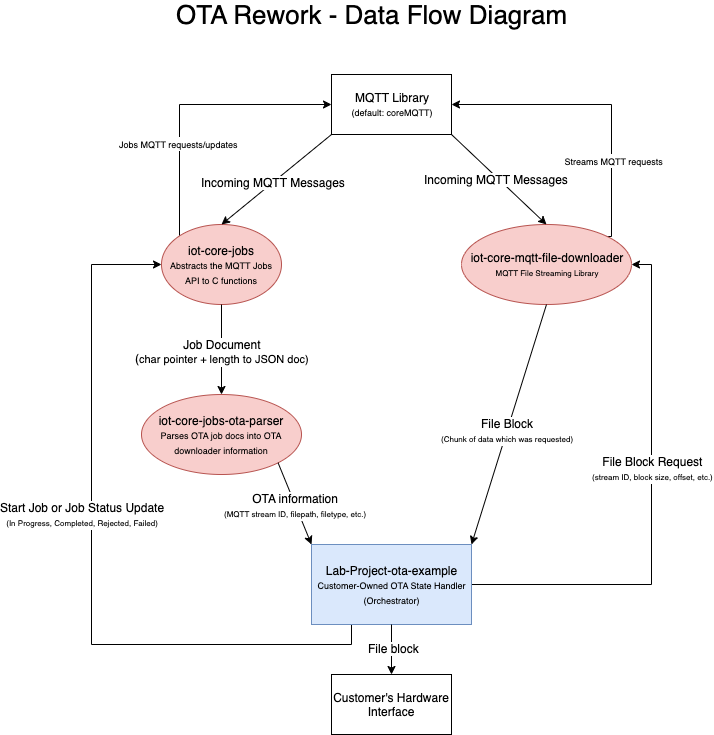# CoreOTA
## Concepts
### Basic Flow Flow
CoreOTA in its most basic form helps to make implementing the overall OTA flow
as simple as possible. This general flow of an OTA update looks as follows:

**Notify** - The device is notified of a pending Over The Air update. This
notification starts the process of deciding how to handle the update. The device
may choose to ignore the update or accept the update triggering the download.
The device will notify the OTA update provider of its choice.
**Download** - The device begins downloading the OTA update over any one of its
supported protocols. The device will download the update to a pre-selected
storage region. This update may be an entirely new firmware image or a patch to
the existing firmware.
**Verify** - The device performs various checks to ensure authenticity of the
downloaded firmware. A robust verification state prevents malicious actors
installing firmware, device corruption, and incorrectly signed updates from
taking place.
**Install** - The device now updates itself (often through a bootloader) to the
newest firmware. Checks may be performed after install to verify functionality.
The device will report the successful firmware update to the OTA update
provider.
## Architecture
Central to CoreOTA's design is the desire for extensibility, customizability,
and configurability. These traits are critical to ensure that CoreOTA can work
on your device with as a little rework as possible. Extensibility manifests in
the form of simplified components which can easily be expanded for enhanced
functionality. CoreOTA remains customizable through swappable components with
robust interfaces allowing for new protocols, update providers, and download
schemes to coexist with already implemented ones. And finally, simple
configurability through easy to modify values setting important behaviors like
download chunk sizing.
These values are implemented through the use of several small 'libraries', each
contained in a 'lib' sub directory. These libraries are each responsible for a
different component of the OTA update allowing for a modular and composable set
of functionalities. Note that all of these components can be replaced to support
new protocols, OTA update methods, and formats.
The dataflow through the various components will look like...

Now for an explanation of the various components...
### The 'IoT Jobs Handler'
**Found in `iot-core-jobs`**
The IoT Jobs handler is the first component used in the overall OTA flow. This
library provides functions to both start a pending IoT Job (shown as Notify on
the diagram below) as well as update a job's status. When the Jobs handler
learns of a new OTA update - coming through an IoT job - the handler will start
the job and pass the job and its metadata on to a chain of parsers. If a parser
is setup to handle the job it will relay back to the job handler that the job
was started successfully. This successful start notification is relayed back to
the OTA update provider (which is IoT Jobs) to mark the update as started. If no
parser is able to understand the job the failure to start the OTA update is
relayed to the provider.
### The 'IoT OTA Parser'
**Found in `iot-core-jobs-ota-parser`**
The OTA parser found in `iot-core-ota-parser` is a single example of an OTA
update parser. The parser will verify the IoT job is an OTA update and parse the
fields into a usable format before calling on the downloader.
### The 'File Downloader'
**Found in `iot-core-mqtt-file-downloader`**
The file downloader provides functionality to download the OTA file. The file
downloader handles downloading the update over an MQTT stream in either CBOR or
JSON format. The download itself if performed on 'blocks' which is easier to
think of as chunks of the overall OTA update file. This is done to increase the
reliability of the download as well as to allow for larger firmware updates than
possible in a single download 'block'.
### The 'Bootloader'
A firmware Bootloader exists to install the new firmware onto the device.
CoreOTA deliberately avoids implementing a bootloader as several industry-wide
bootloaders already exist with a large range of supported microcontrollers.
CoreOTA leaves the choice of the bootloader and its features up to the user.
### The 'Orchestrator'
**An example orchestrator can be found in `demo/ota_demo.c`**
And finally, the orchestrator synchronizes all of the components mentioned above
along with a bootloader and memory pool to perform the OTA update once
downloaded. Think of the orchestrator as the leader of a symphony - it orders
the other components to make an OTA update possible, from being notified to
downloading to later installing the firmware.


